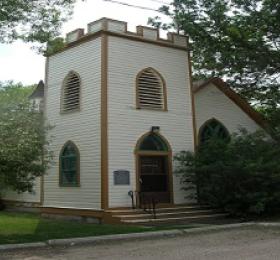Rugby Chapel
- Designated
Description of the Historic Place
The Rugby Chapel is a wood frame, single-storey chapel built in 1911. It is situated on a parcel of land on the University of Saskatchewan campus adjoining College Drive.
This historic place was designated as a Municipal Heritage Property in 1987. The designation is limited to the exterior of the building.
Heritage Value
The heritage value of the Rugby Chapel resides in its association with the history of Anglican education in Saskatchewan, and of the University of Saskatchewan. Constructed after the move of the Anglican Emmanuel College from Prince Albert to Saskatoon in 1908, the Rugby Chapel is the first Anglican permanent place of worship built on the campus of the University of Saskatchewan. Built with funds raised by students, the chapel has served the needs of the Anglican community on campus for 54 years, gradually becoming a repository for religious artifacts associated with the Anglican tradition in Canada.
The heritage value of the Rugby Chapel also lies in the chapel’s architecture and its historical integrity. Built in the Gothic Revival style, it resembles the design of many English stone-built churches featuring a Norman tower with a parapet, stained glass windows and exposed rafters. It is one of the few remaining Anglican places of worship in Saskatoon that is constructed of wood and one of the few wooden buildings still remaining on the grounds of the University of Saskatchewan. Its interior and exterior have remained virtually unchanged since its construction.
Source: City of Saskatoon Bylaw No. 6807/ City of Saskatoon Built Heritage Database / Canadian Register of Historic Places
Character Defining Elements
Key elements which contribute to the heritage value of this historic resource include:
- Those elements reflecting the Chapel’s association with the history of Anglican education and the University of Saskatchewan, especially its placement on its original site;
- Those elements reflecting the Chapel’s historical integrity, such as its wood frame construction, particularly the hand-hewn beams, the wainscoting, wood panelled ceiling, exposed timbers, hardwood flooring and the central stained glass window; and
- Its Gothic Revival style of architecture, evident in: its tower, window design, the cruciform layout of its interior, its vaulted ceiling and its Emmaus stained glass window.


